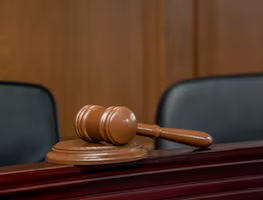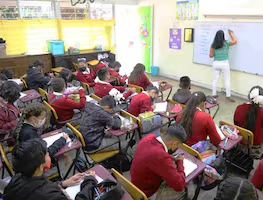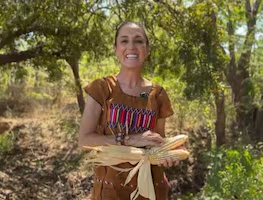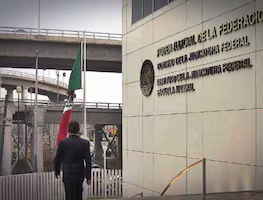Más Información

Magistrado Reyes Rodríguez propone validar registros de aspirantes con promedio inferior a 8; excluirlos es “estigmatizante”, señala

¿Eres madre trabajadora? Puedes acceder a las guarderías del IMSS; descubre los requisitos y cómo hacerlo

El primer megapuente de 2025 se acerca; ¿cuándo inicia y qué estudiantes tendrán descanso de 4 días?

Sheinbaum reitera protección a maíz mexicano; iniciativa enviada al Congreso rechaza siembra de trangénico
Jorge Antonio Tizapa Legideño
, one of the 43 Ayotzinapa students who went missing in September 2014, was allegedly seen in Mexicali , Baja California. In case the man is the student, he is currently homeless.

On September 15, the Interior Ministry, through the National Search Commission, asked the search commission in Baja California to launch an operation to confirm if the man is the missing student.
According to reports, the victim’s family saw a picture of the man on social media and requested help from the National Search Commission.
The operation to look for the man started on September 21 and it will end on September 23. Both federal and state authorities are participating in the search, as well as staff from the local prosecutor’s office, the National Guard, and state forces.
Some of Tizapa Legideño’s family members traveled to Mexicali to participate in the search. Volunteers also joined the operation.
Recommended: Ayotzinapa: the timeline of a tragedy
According to Peña Nieto’s administration, local cartel Guerreros Unidos massacred and burned the students’ bodies in a dumpster in Cocula; however, experts have challenged this version on different occasions.
When Andrés Manuel López Obrador took office in late 2018, he vowed to solve the case. He created a special commission for the Ayotzinapa case and meets with the victims’ parents every few weeks.
Experts identify the remains of missing student
In July, the Attorney General’s Office announced that it had launched a search in Cocula, Guerrero, between November 21 and November 29. Mexican authorities searched a place called Barranca de la Carnicería, Ejido de Cocula, not the Cocula dumpster where Peña Nieto administration’s focused its investigation.
During the search, experts found 15 pieces of evidence. The victims’ parents and the special commission created to investigate the Ayotzinapa case were also present.
On February 26, the evidence was analyzed by experts from the Attorney General’s Office while the families’ representatives and experts from the Argentinian Forensic Anthropology Team were present.
Six pieces of evidence were sent to the Innsbruck University, where they were analyzed. It takes between three and five months to obtain DNA results.
On June 19, the Innsbruck University announced that after analyzing the bones found by the FGR, it found that one of them belonged to Ayotzinapa student Christian Alfonso Rodríguez Telumbre, one of the young men who went missing on September 26, 2014.
After the Austrian university released its results, the Argentinian Forensic Anthropology Team analyzed the remains once again, confirming they belonged to Christian Alfonso.
On July 5, authorities traveled to Tixtla, Guerrero to inform the family about the DNA results.
Recommended: Independent experts will investigate the enforced disappearance of the 43 Ayotzinapa students
This is the first major finding in over five years. The statement released by authorities emphasized that human remains weren’t located in the Cocula or the San Juan River.
The statement adds that more remains will be sent to the Innsbruck University.
On 26 September 2014, 43 students from the Ayotzinapa Rural Teachers' College were the victims of enforced disappearance in Iguala, in the state of Guerrero. The burned remains of one of them were found weeks later but the other 42 are still missing.
Nearly six years after 43 students disappeared in Iguala, Guerrero, Attorney General Alejandro Gertz Manero confirmed Tomás Zerón, the case’s chief investigator, fled the country months ago. Gertz Manero added that prosecutors had requested 46 arrest warrants for municipal officials in the state in connection to the enforced disappearance case.
In September 2019, Zerón was accused of torturing suspects involved in the enforced disappearance of the 43 Mexican students and of manipulating evidence.
The original investigation concluded in what the Jesús Murillo Karam, then-Attorney General, called the “historic truth” that the 43 students from the teaching college at Ayotzinapa were abducted by police in Iguala in September 2014 and handed over to drug cartel Guerreros Unidos, which killed them and burned their bodies. However, independent experts found numerous flaws in the investigation.
Since the Attorney General’s Office started the investigation under Gertz Manero, additional remains have been recovered and sent to the University of Innsbruck in Austria for identification.
One central character, “El Mochomo,” an alleged founder of Guerreros Unidos who was blamed for the students’ disappearance, was arrested, released, and then arrested once again.
Guerreros Unidos
The criminal organization is currently active and operates in Guerrero and the State of Mexico.
The Guerreros Unidos Cartel is part of the larger Beltrán Leyva Cartel. It has an important participation in the heroin trade and was involved in the disappearance of the Ayotzinapa students.
The Guerreros Unidos traffics cocaine as far north as Chicago in the United States and reportedly operates primarily in the central and Pacific states of Guerrero, State of México, and Morelos.
The Guerreros Unidos, according to Mexican authorities, was responsible for taking the 43 Mexican teacher trainees, who were handed to them by local authorities in Iguala, Guerrero; the group allegedly murdered the students and burned their bodies.
The DEA maintains that the Guerreros Unidos are known to traffic heroin and other drugs into the United States.
gm






